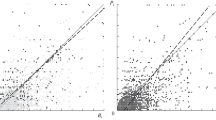Abstract
Two test images are decomposed into sequences of ten ordered images which result from a clustering of pixels. The first image is supposed to contain pixels belonging to edge, the tenth image — pixels belonging to region interior. The remaining images gradually change from edge related to interior related. The clustering is provided by the so called Grade Correspondence — Cluster Analysis (GCCA), described in lastly published book on grade models and methods for data analysis. The GCCA is applied to the data matrices formed by a set of 12 variables which include gradient module, gray level, and ten variables describing the nearest neighborhood of each pixel according to the increasing level of module diffierentiation. Data matrices are visualized in form of the so called “ordered overrepresentation maps” and “grade stripcharts”.
Access this chapter
Tax calculation will be finalised at checkout
Purchases are for personal use only
Preview
Unable to display preview. Download preview PDF.
Similar content being viewed by others
References
Kowalczyk T., Pleszczynska E., Ruland F. (eds.) (2004) Grade Models and Methods for Data Analysis, With Applications for the Analysis of Data Populations. Series: Studies in Fuzziness and Soft Computing, vol. 151, 477 p., Springer Verlag Berlin Heidelberg New York.
Author information
Authors and Affiliations
Editor information
Editors and Affiliations
Rights and permissions
Copyright information
© 2005 Springer-Verlag Berlin Heidelberg
About this paper
Cite this paper
Grzegorek, M. (2005). Image Decomposition by Grade Analysis - an Illustration. In: Kurzyński, M., Puchała, E., Woźniak, M., żołnierek, A. (eds) Computer Recognition Systems. Advances in Soft Computing, vol 30. Springer, Berlin, Heidelberg. https://doi.org/10.1007/3-540-32390-2_45
Download citation
DOI: https://doi.org/10.1007/3-540-32390-2_45
Publisher Name: Springer, Berlin, Heidelberg
Print ISBN: 978-3-540-25054-8
Online ISBN: 978-3-540-32390-7
eBook Packages: EngineeringEngineering (R0)




